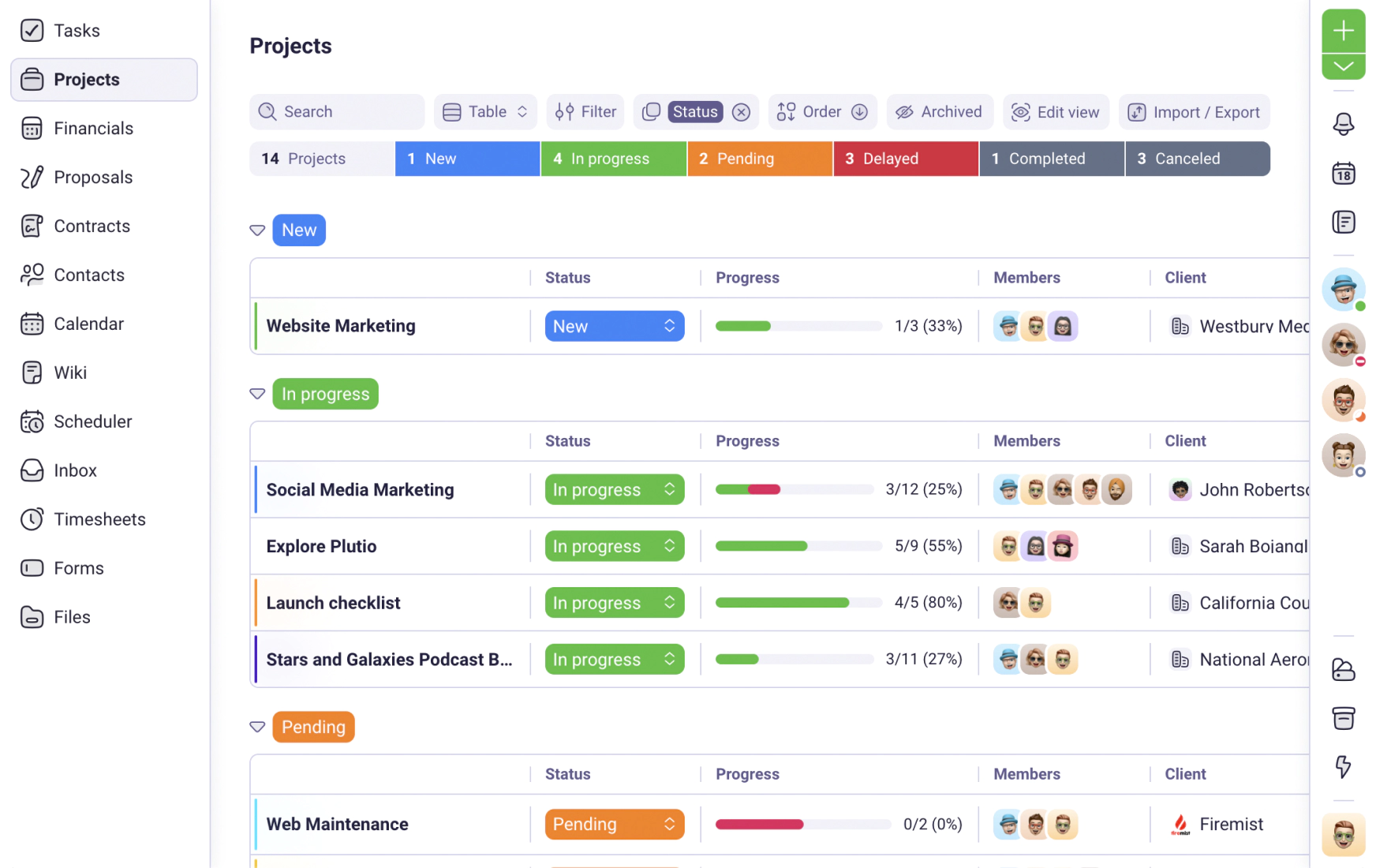We use cookies to personalise and enhance your experience.

Freelancers have to do everything themselves, from applying for work to managing clients, to staying on top of their finances. For some, such self-reliance is part of the excitement of becoming a freelancer in the first place. In fact, according to a study, 77% of people said they started freelancing to become their own boss. Others, however, find it too much of a challenge when client projects pile up to the extent where they simply burn themselves out.
Having lots of work as a freelancer sounds like a good thing in theory. But a busy schedule doesn’t always equal financial success, with 59% of freelancers claiming to be living paycheck to paycheck.
Fortunately, there are solutions.
In this article, we’ll be taking a look at how to manage multiple client projects as a busy freelancer. This will allow you to make the most of your time and grow your business while finding new and exciting opportunities.
Write Down Your Tasks
Before we discuss the need of creating a schedule, it’s first of all important that you make a note of all the tasks that need to be completed at the moment. If instead you work inside your own head and don’t draw up a task list, it can be easy to a) forget certain tasks and b) mistakenly prioritize the wrong tasks.
Before you do anything else, then, make a note of all your current outstanding tasks so that you know what you’re dealing with right now.
Schedule Ahead of Time
Freelancers who fail to plan their week ahead could find themselves swamped with work as the week goes on. While regular employees have their weekly schedule already laid out for them, freelancers must take the reigns and plan everything themselves.
Scheduling ahead of time gives you a complete overview of your weekly work, allowing you to stay organized and on track, and it also makes it easier for you to track your time. It gives you the chance to be flexible with your schedule, too, should any surprises appear, such as a client asking for unexpected changes, or any new jobs appearing.
A schedule starts with your planned working hours. Map them out for each day, creating blocks of work if necessary. A time blocking schedule looks like this:
- 8 am - alarm
- 8 am-8.30am - get ready for the day ahead
- 8.30am-9.15am - shower and prepare breakfast
- 9.15am-9.30am - check emails
- 9.30am-10.30am - work on project A
- 10.30am -11.00am - Skype call with Client B
And so on.
If you’re not the type of person to schedule according to time, consider schedules according to projects. And keep in mind: research shows that scheduling when and where you’ll do something makes it dramatically more likely that the task will get done.
Prioritize
To help with your schedule, it’s a smart idea to prioritize. Prioritizing tasks not only makes it easier to schedule, it also helps you to stay on top of your work so that you don’t procrastinate, delay and miss deadlines. It’s by prioritizing that you know what you need to work on first, second and last. This then creates more flexibility in your schedule and helps you stay focused.
To help you prioritize, you can draw up a to-do-list and arrange your tasks in order of a) importance and b) deadlines. Doing this means work that is due soon doesn’t get forgotten about, and as a result you reduce the risk of stress and burnout.
To help you prioritize, here are some tips:
- Highlight those tasks that are most pressing/urgent
- Write down the due date for each task so you can see which ones need to be done soon, and which have more wiggle room
- Consider working on tougher projects first. When you get the harder projects out of the way, things don’t look so bad
- Prioritize according to how much a job earns if that works best for you
Communicate With Your Clients
Clients don’t always set deadlines in stone. In fact, there are clients who are loose and easy with deadlines, and who simply don’t set them at all. Conversely, there are clients who are aggressive with deadlines.
To ensure that a project gets completed on time without any reduction in quality, and to ensure that your projects don’t get on top of you, it’s a smart idea to communicate regularly with your clients. Can they perhaps be flexible with their deadlines? When is a reasonable time for you to complete a project by?
Especially if you expect delays, it’s important to mention this to the client at the earliest opportunity.
But communicating with clients is about more than just discussing deadlines. It’s about building and nurturing relationships so that the two of you can be open about ideas, project timelines, deadlines and more.
To strengthen relationships and the way you communicate with clients, consider installing live chat on your website so you can directly speak with your clients in real-time.
Consider Outsourcing
For some busy freelancers, outsourcing is just par the course. For others, it’s a last resort.
If outsourcing your work makes you feel uneasy, it’s important to understand that it’s simply something that all businesses around the world do. Outsourcing relieves the burden placed on you and allows an extra pair of hands to tackle your projects.
Outsourcing comes with its own challenges. You need to make sure that you outsource your projects to equally experienced freelancers, and you need to balance quality with budget so that you don’t cheat either yourself or your client.
You also need to identify exactly what should be outsourced. Do whole projects need to be outsourced or specific components? Once you’ve agreed to work with a fellow freelancer, make sure you communicate all important points about a project so that they have everything they need to make a start.
Know Your Worth
Freelancing is difficult because there is so much competition. Sometimes, freelancers get trapped in a race to the bottom. When this happens, they lower their rates simply to get more work.
The problem with having low rates is that you inevitably take on more work to compensate for loss of earnings. It’s therefore important that you know your worth and price yourself accordingly so that you work with clients who a) value you and your talents and b) pay you enough so that you don’t have to take on more work than you can manage.
How do you define your worth as a freelancer?
There is, unfortunately, no universal answer to this. You don’t want to price yourself so high that you price yourself out of potential work, but you also don’t want to price yourself too low. Here are some tips:
- Consider your experience and how many years you’ve been doing this, as well as how many projects you’ve worked on, and what level of client you’ve worked for
- Consider your expertise. Do you have a brand? Do you have lots of social media followers that you can leverage when applying for work?
- Always take into account a client’s timeline. The tighter their deadlines are, the more you can raise your price
Remember That You Have the Freedom to Say “No”
Lastly, it’s essential that you remind yourself that you have the power to say No. One of the reasons freelancers get overloaded with work in the first place is they decide to tackle every project that is thrown their way.
You must ask yourself whether any project offered to you is worth it. Does it pay enough? Is your calendar already full? Are you only taking the job on because you’re worried another one won’t come along? Do you have the skills required?
When we reserve the ability to say No to a project, we not only do the right thing for us, we also do the right thing for the client. If you know deep down that you don’t have the time to fit another project in right now, consider politely turning it down, or perhaps try to negotiate an arrangement with the client whereby you extend their original deadline.
Wrapping Up
While it’s advisable that a freelancer must never take on more work than they can manage, the life of a freelancer is never that simple. Sometimes, the inevitable happens and you as a freelancer are left trying to manage multiple client projects.
Use the tips in this article to ensure that both you and your clients get the best out of your talents. Create schedules, prioritize tasks and learn both your worth and the power to turn down projects.
Author Bio
Ashley Kimler is the founder of CopyNoise. She's been working remotely in the tech space since 2014. Interested in getting her advice on your blog? She's always looking for the opportunity to share her perspective with new communities! Follow @ashleykimler on Twitter to see what's new.
Have you tried Plutio yet?
The only app you need to run your business and get work done.
Try Plutio for FREESupercharge your business
The complete toolkit to run your business
The intuitive all-in-one solution to manage and collaborate on projects, share files, build forms, create proposals, get paid, and automate your workflow.
No credit card required


